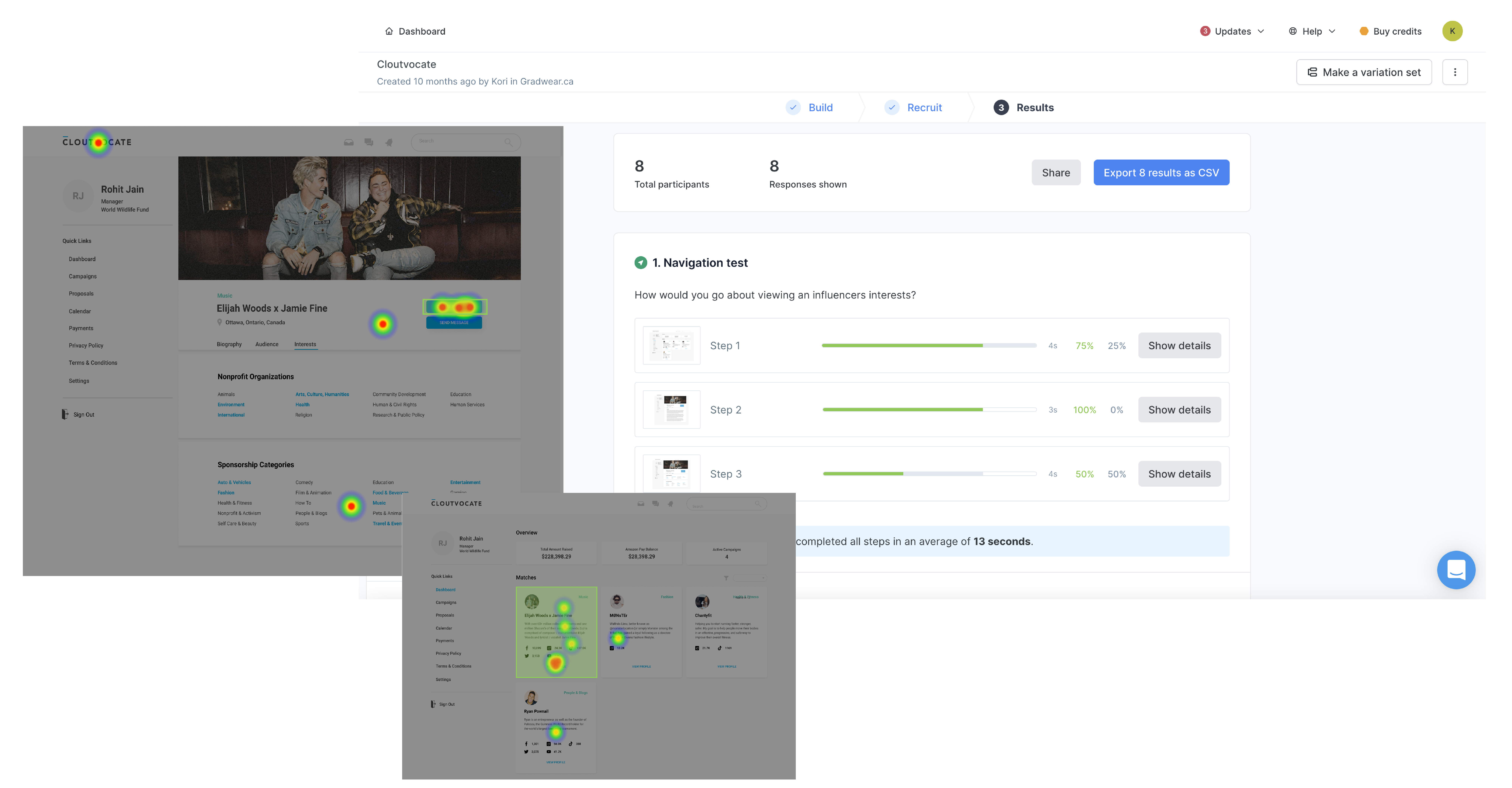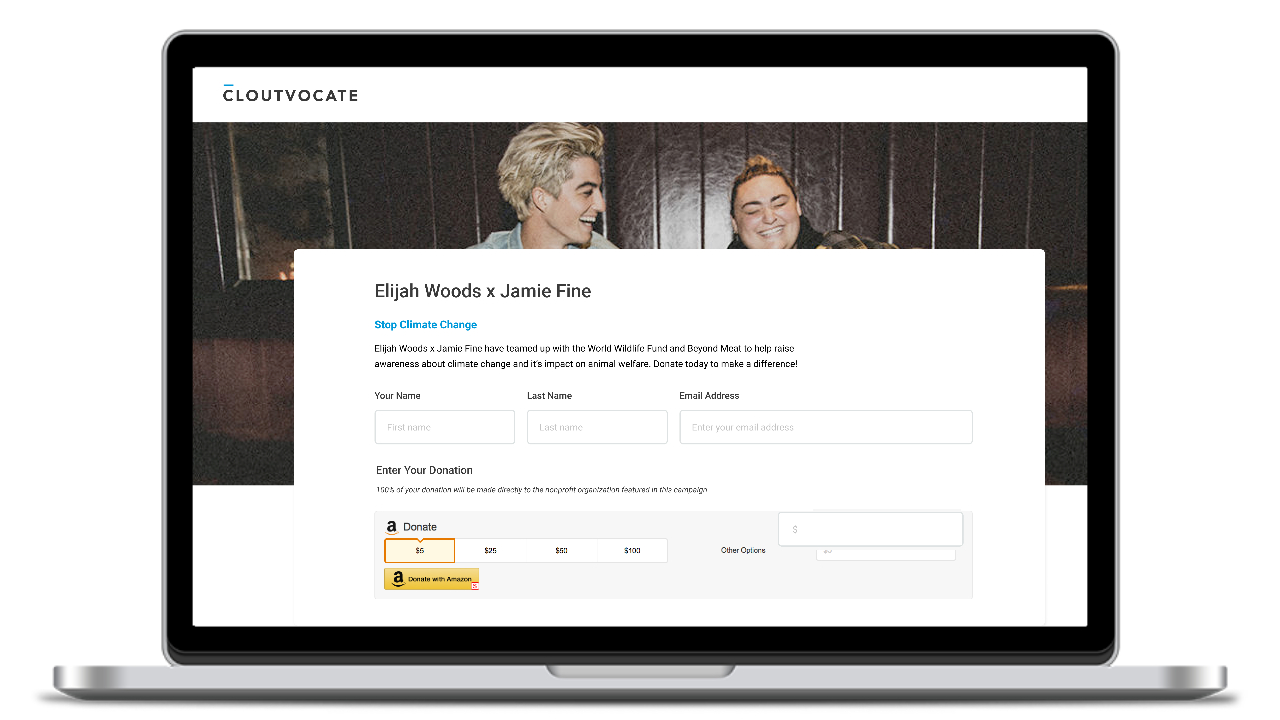Cloutvocate
A matchmaking platform to connect nonprofit organizations with influencers and sponsors to elevate meaningful causes and drive vital donations


TIMELINE
May - July 2020
PLATFORM
Web Application
ROLES
Design Sprint Lead, Research, Product Strategy, UI/UX Design
TEAM
Hendy Irawan (Back-End Dev), Romeo Radanyi (Solutions Architect), Rohit Jain (Front-End Dev), Shelli Gorokhovsky (Data Scientist), Michelle Zyman (Data Scientist)
OVERVIEW
Amazon Inspires Action to Ensure the Survival of Nonprofit Organizations and Cultural Institutions
As an outcome of the global pandemic, nonprofit organizations have been presented with unprecedented challenges in generating the vital donations they need to ensure their survival. To inspire action, Amazon launched the Raise-Up Buildathon, challenging participants to use AWS technology to create new and sustainable ways for these organizations to achieve their fundraising goals. This advanced technology allowed our team of six to rethink the traditional practice of brand and influencer collaborations via an innovative matchmaking platform. This app was designed to help donors and influencers alike “give back” in a manner that provides value to all parties involved.
THE PROBLEM
Unprecedented Economic Challenges Create Barriers for Nonprofit Organizations
Social distancing practices have forced nonprofits to reinvent their methods of raising awareness, as well as their fundraising efforts in order to reach new audiences and drive the critical donations needed to operate and grow. In today's digital world, influencer marketing is becoming an increasingly beneficial strategy to reach new generations of donors on a global scale. However, the process of building the right partnership is both arduous and time-consuming, and representatives of nonprofit organizations are often required to manually search for influencers and sponsorship partners. The current mechanisms often lead to rejection emails, or no response at all. Compounding complexity are the challenges faced when organizations are searching for niche-appropriate influencers. This makes it difficult to target calls to action to the right audience for the cause.
DESIGN CHALLENGE
How might we design a product to help nonprofit organizations reach, connect with, and inspire action from the right audiences to provide long-term sustainability in an uncertain world?
THE SOLUTION
Leveraging Optimized Social Popularity to Help Nonprofits Adapt to a Changing Landscape of Patron Engagement
Cloutvocate is an AWS-powered platform designed for nonprofit organizations to connect with the right partners to augment campaign awareness and drive the vital donations needed to operate and grow. This matchmaking platform has been designed to bridge existing gaps between non-profits, donors, and the influencers that facilitate engagement. Recognizing where friction exists in the current nonprofit-influencer business model, our team has created a platform that integrates a corporate sponsorship component to funnel more revenue into a nonprofit’s cause, incentivize influencers, and align corporations with well-matched social causes and coveted audiences.

ROLE & RESPONSIBILITIES
Uniting Skill Sets From Across the Globe to Solve An Emerging Problem
The team was developed using Devpost. Each member was selected according to their unique skillset and background—forming a small, agile, and autonomous team of six dedicated students and industry professionals from around the globe. Our team consisted of a backend developer (Hendy), a frontend developer (Rohit), two data scientists (Michelle and Shelli), a solutions architect (Romeo), and myself as the team lead and UI/UX designer.
My role was to lead the Design Sprint at the outset of the challenge. I was also responsible for creating the user interface and user experience, site map, and usability testing. Further to this, I created the visual identity for Cloutvocate where I designed the illustrations and selected the grid system, typography, and color palette used.

PROJECT SCOPE & TIMELINE
Defining Key Tasks to Deliver a Winning Solution
Aside from the complexity of the problem, time was one of the biggest constraints we were faced with. To combat this, the team created a clear project scope and timeline at the outset of the challenge. This was done to ensure the efficient and effective investment of time—our most precious resource.

DESIGN PROCESS FRAMEWORK
Using a Design Sprint to Solve a Business-Critical Challenge in a Short Period of Time
In order to move forward quickly and efficiently, we decided to use a Design Sprint to help us identify a promising solution within the first week of the challenge. It was important that everyone within our cross-functional team was able to contribute equally – sharing information and sketching ideas, each solving their own part of the problem, each ready to answer the others' questions – while also being certain that the development requirements were manageable within the timeframe allotted.

TOOLKIT
Building the Right Experience Begins with the Right Tools
The tools used for this challenge were selected based on services offered by Amazon, products that could support teams working remotely, as well as the best option for sound developer hand-off. Miro acted as our primary "whiteboard" which allowed for simultaneous visibility of each step in the design sprint and workflow organization and Figma was used for prototyping and developer handoff. Additional tools include the following:


Map
LONG-TERM GOAL
Setting the Stage by Starting at the End to Identify Long-Term Goals
At the start of the event, the AWS team hosted a keynote presentation where they laid out the challenges nonprofit organizations and cultural institutions currently face, as well as opportunities to utilize AWS services to alleviate these pain points. Using these insights as our starting point, we identified the long-term goals of the project. These acted as our navigational compass through design and feature decisions. These goals were as follows:

HMW QUESTIONS & AFFINITY DIAGRAM
HMW Questions Identify Problem Spaces
The next step was to rephrase each problem mentioned during the keynote into a series of “How Might We” questions. These questions were then organized into an Affinity Diagram which helped us sort and prioritize questions based on recurring themes and categories outlined by the AWS team. The group then voted on questions they felt offered the greatest potential for viable solutions within the given timeframe. Each question inspired multiple ideas that the team was able to collectively review and run through. We decided to focus on Nonprofit Fundraising as our area to focus on for the sprint.

NOTE-N-MAP
Narrowing a Broad Challenge into a Specific Target
A note-n-map strategy was used to help us define who the target users might be, what their journey might look like between their starting points and expected destinations, and how customers or stakeholders might interact with the solution being designed. The map was then annotated with different notes based on insights gathered from the AWS keynote, and our shared understanding of those insights. The outcome revealed a customer-centric map rooted in a story with a beginning, middle, and end that framed target opportunities for consideration.


Sketch & Decide
LIGHTNING DEMOS
Remix and Improve: Looking at Solutions from a Range of Companies
Tom Freston, the co-founder of MTV, once said, "innovation is taking two things that exist and putting them together in a new way". Every great invention is built on existing ideas. The Lightning Demos phase allowed us to collectively review existing solutions to remix and improve. This is where having a diverse team from across the industrial spectrum became a serious asset. Every team member has unique insights from varied perspectives outside of the nonprofit space. Far too often, “new” ideas come from within organizations or industries creating silos that lack innovation and inspiration. Together, using Pinterest, Behance, Dribbble, existing donation, and crowdfunding sites, the team gathered content that was used to inspire and inform our solution and lead us to originality. Much to our surprise, the launchpad of our solution came from the unlikeliest of places: A Mr. Beast and Ninja YouTube video.

CRAZY 8'S
Harnessing the Power of Sketching to Develop Creative Solutions Quickly
With the initial concept of a matchmaking platform in mind, a Crazy 8’s exercise was introduced. This was done to generate solution sketches quickly—and healthy competition between various ideas. This promoted debate and led to outside-the-box thinking. We found this to be an ideal method of generating high-quality potential solutions while maximizing participation from the team. Dot voting was then used to give everybody the chance to review the ideas and weigh in on which parts they like best and which of those ideas we wanted to move forward into the prototyping phase with.

STORYBOARD
Mapping Out the Experience to Determine MVP Requirements
With a short timeline and the end-of-week test with customers looming ahead, it was certainly tempting to jump straight into prototyping as soon as the concept for our solution was identified. Far too many projects doom themselves by doing this. Prototyping without a plan leads to getting bogged down by seemingly insignificant, but unforeseen questions. The winning sketches were strung together into a cohesive storyboard. This provided us with a foundation to imagine the finished prototype to spot problems and points of confusion before the prototype was ever built. Our storyboard identified and outlined micro-moments—small decisions users would encounter along the way—that served to guide design throughout this phase.


Prototype
USER FLOW & SYSTEM ARCHITECTURE
Achieving Product Goals Through Path Visualization
While the storyboard gave us a deeper understanding of how users might navigate the product, the team decided to delay the sprint by a day to identify how AWS services would play a role in the creation and delivery of our solution. Of equal importance, we needed to establish the value proposition that would set us apart from the competition. Together, we created a user flow to ensure our system requirements were aligned with the product vision, and that all the challenge requirements were being met for the two categories we were aiming for—Best in Nonprofit Fundraising, and Best in Nonprofit Fundraising - AmazonPay Integration. We crafted a flow that maximized the conversion of product visitors into users, and ultimately into donors and advocates.


RAPID PROTOTYPING
Creating a Visual Model of an Envisioned Product
By taking a few extra days in the design phase, we ensured that Rohit was presented with a design that could be translated into a usable platform. If the concept failed, the team would have reusable components—with an understanding of what we could implement should the need to explore new designs arise. Ultimately, prototypes are disposable—the option to reiterate, add, or omit is always there. Given our tight time frame though, the team had to ensure we designed just enough, and not more than was necessary. Although our prototype was rough, we felt comfortable proceeding to the next stage. Prolonging prototyping in search of perfection would only serve to slow down our process.


Test
USER TESTING
User Testing Leads to Meaningful Results in a Short Period of Time
Armed with a promising solution, it was time to test our prototype and see how people react to the solution. We began using our personal networks to schedule interviews with five users that matched our target. The objective of the interviewee was to complete a series of tasks within the prototype. Open-ended questions were asked to understand their thoughts about, and experiences with the prototype. This yielded crucial reactions and spot patterns data for usability and desirability of the product. The testing showed that the concept was a success.

SUBMISSION
From Sprint to Success: Cloutvocate Wins Best in Nonprofit Fundraising!
When the day came that we received the email notifying us that we had been selected as winners of the buildathon, the team was beyond thrilled knowing how hard everyone worked to make this win possible. From a total of 828 participants in the buildathon, and 74 projects, our project was chosen. We also hit our second target by winning the main prize of “Best in Non-Profit Fundraising”. We ended up winning the main prize under the "Best in Non-Profit Fundraising" category.

Outcome
KEY FEATURES
A Convergence of Tech, Influencers, And Philanthropy
In today's digital world, influencer marketing is becoming an increasingly beneficial strategy to reach new generations of donors on a global scale. Demographics not typically associated with philanthropy can now be reached. Targeting millennials through influencer marketing campaigns is a proven way to grow a business, and can also help nonprofit organizations reach coveted audiences in an organic way. The millennial population currently represents the largest segment of social media audiences; thus, leveraging the role of social media influencers as part of a nonprofits awareness strategy can play a vital role in the success of a campaign.
Cloutvocate is a new and innovative product designed to leverage the power and reach of influencer marketing to raise donations to worthy nonprofits. Built upon AWS technology, Cloutvocate is designed to connect nonprofit organizations with influencers and sponsors to take campaign awareness beyond traditional borders, and raise funds needed to grow, operate, and serve their cause.

Streamlined Onboarding
Users are able to sign up as either a nonprofit organization, social media influencer, or corporate sponsor where a series of onboarding questions help to determine matches based on the user’s chosen parameters.

Quick & Easy Campaign Launch
Nonprofits initiate campaign launches with a fully integrated proposal creation system. The proposal is then sent to a curated list of influencers who align with their mission goals to either accept or decline.

Sponsorship Marketplace
Once an influencer accepts a proposal, they may also decide to donate a % of the campaign revenue back to the nonprofit organization in exchange for a tax receipt. The proposal then enters into the marketplace for a sponsor to buy into.

Partnerships for the Greater Good
Sponsors are given a chance to review the treatment and decide whether or not buying into the campaign is of interest to them. The sponsor is provided an opportunity to indicate how much of a sponsorship contribution they are willing to make in exchange for brand integration within the content.

Dontate Using AmazonPay
Payments between partners or from audience donors are facilitated using AmazonPay
LEARNINGS & TAKEAWAYS
New Challenges Present New Opportunities To Learn
By matching non-profits with donors and niche-specific influencers, we’re able to create a mutually beneficial arrangement for all parties. This in turn allows donations to flow into areas where they will do the greatest good.


KORI SKEFFINGTON
© 2021 All Rights Reserved
CONTACT
SOCIAL